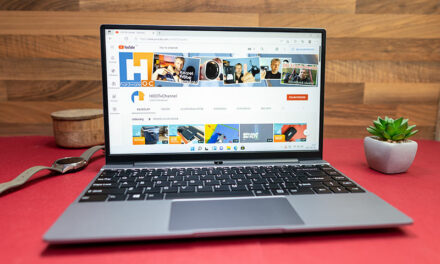
Introducing the ASY N53SN notebook with Sandy Bridge
Az Intel Sandy Bridge’s architecture has brought many improvements and positive features. In addition to the general acceleration of central units, consumption has been curbed, which is a particularly important aspect in the mobile market. Each of the new mobile Sandy Bridge-based processors includes an integrated graphics core as a feature of the architecture. The good news for the notebook market is that every mobile CPU gets the more powerful, i.e. the IGP 3000 graphics core. Significantly subdued consumption allows more powerful mobile devices to have processors that can grow in performance alongside their desktop counterparts.
One such model is the ASUS N53SN, which amplifies the ASUS N series. On the outside, at first glance, we don’t notice anything surprising about it. The brushed aluminum cover has been encountered several times, it gives a nice, elegant look and is more solid than the plastic cover. The standard ASUS branding on the cover tells you what kind of machine we are dealing with. A special layer has been placed on the edge of the cover (where the display is opened), we think the purpose of this is not to crimp together brushed aluminum that is not sensitive enough to scratches. The brushed aluminum effect is otherwise present throughout the machine housing, with a thin silver stripe running along the side edges and at the front, raising the ambiance of the machine's appearance. Where not gray metal, we encounter black plastic, for example on the sides of the machine. If we're already here, let's see what got up here!

Going from the top on the left, we find the spacious ventilation grille, where the warm air leaves the notebook. Going a little lower, you can see the external antenna connector and HDMI output hidden under the cap. These are followed by the RJ45 LAN connector and the memory card reader slot. In the remaining area, there may be a difference between each build. You can see two USBs in the factory photos, and both are special. The left (black) supports not only USB but also eSATA, while the right (blue) also supports USB 3.0. The machine we visited did not have a combi connector, the USB 2.0 port could not be used as eSATA.
Most of the back of the machine is occupied by the battery, but here you will find the Kensington lock and the smooth VGA output in case you need to connect to an older display and it is not possible to use HDMI. On the other side is the charger connection point.
The right side of the machine (from above) starts with the WiFi switch and optical drive. At this point, there may be a difference again, the factory pictures show a traditional DVD burner, while our machine included a Blu-Ray burner. Some pieces come with a combo drive, meaning Blu-Ray discs can only read. In addition to the optical drive, we find two more traditional USB (2.0) and audio-related ports, namely the headphone output and the microphone input. Nothing was placed on the front of the machine anymore, maybe not because it was thin enough. By the way, this can be said for the whole machine. Another interesting solution is the design of the hinges, the interlocking curved surfaces provide a pleasant sight.
It’s time to also look at what we find on the inside of the ASUS N53SN. First up is a 15,6 ″ 16: 9 aspect ratio display with LED backlight and Slendid technology. The panel resolution can be 1366 × 768 or 1920 × 1080 (Full HD), the latter is not recommended for visually impaired people for this size. The hosted machine included the Full HD panel.

Below the display is the usual silver ASUS logo, and above it is the 2 megapixel webcam, which features a small shutter that allows you to lock the camera manually, much like when you put the lens cover on your handheld. This way, they can't even get possession of any images if our machine might be the victim of some kind of attack and they want to access our webcam. The frame surrounding the display has a glossy surface, so you can collect fingerprints with pleasure.
Let's move on to the more interesting parts! The speakers are hidden under a silver-gray cover that fits the style of the cover, and were supplied by Bang & Olufsen ICEPower for the notebook. How they behave sharply will be discussed later. Below the sound bar there are control buttons on both sides. On the left, you can use the wide key to navigate through the power schemes, and you can use mute, volume down, volume up, and play / pause keys. On the right we find the power button itself and three indicator LEDs, which go from left to right: Num Lock, Caps Lock, GPU activity LED (white: discrete VGA, blue: integrated VGA), power LED.
Then comes the keyboard, which can also have a numeric pad. The keys are large enough and easy to use. Their design is interesting, their edges are broken, we haven't come across an ASUS notebook with such a keyboard on our own, but we couldn't complain about its use. The area under the buttons is again brushed aluminum, this time colored black according to the internal surfaces.
The touchpad serves some interesting features, such as two-finger scrolling (no separate scroll bar) and two- and three-finger right mouse button functions. Their use is as follows:


The left and right mouse buttons are made of a plastic element. Below this are four more LED indicators to inform you about the status of WiFi, hard drive, battery and on power.

In conclusion, the ASUS N53SN has got an attractive and sophisticated look. It can't be called a breaker, it follows a well-proven recipe, it has a place in the office and in business. The 15,6 ″ display gives the basic size of the machine, which is 39,1 cm wide, 26,6 cm deep and 3,05 ~ 4,05 cm high. The notebook weighs an average of 6 kg including the 5200-cell 2,7 mAh battery.
Pages: 1 2























